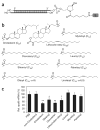Lipid-Drug Conjugate for Enhancing Drug Delivery
- PMID: 28080053
- PMCID: PMC5477224
- DOI: 10.1021/acs.molpharmaceut.6b01027
Lipid-Drug Conjugate for Enhancing Drug Delivery
Abstract
Lipid-drug conjugates (LDCs) are drug molecules that have been covalently modified with lipids. The conjugation of lipids to drug molecules increases lipophilicity and also changes other properties of drugs. The conjugates demonstrate several advantages including improved oral bioavailability, improved targeting to the lymphatic system, enhanced tumor targeting, and reduced toxicity. Based on the chemical nature of drugs and lipids, various conjugation strategies and chemical linkers can be utilized to synthesize LDCs. Linkers and/or conjugation methods determine how drugs are released from LDCs and are critical for the optimal performance of LDCs. In this review, different lipids used for preparing LDCs and various conjugation strategies are summarized. Although LDCs can be administered without a delivery carrier, most of them are loaded into appropriate delivery systems. The lipid moiety in the conjugates can significantly enhance drug loading into hydrophobic components of delivery carriers and thus generate formulations with high drug loading and superior stability. Different delivery carriers such as emulsions, liposomes, micelles, lipid nanoparticles, and polymer nanoparticles are also discussed in this review.
Keywords: chemical bonds; conjugation; drug delivery; lipid; prodrug.
Conflict of interest statement
The authors declare no competing financial interest.
Figures





References
-
- Wonganan P, Lansakara-P DSP, Zhu S, Holzer M, Sandoval MA, Warthaka M, Cui Z. Just getting into cells is not enough: mechanisms underlying 4-(N)-stearoyl gemcitabine solid lipid nanoparticle’s ability to overcome gemcitabine resistance caused by RRM1 overexpression. J Controlled Release. 2013;169:17–27. - PMC - PubMed
Publication types
MeSH terms
Substances
Grants and funding
LinkOut - more resources
Full Text Sources
Other Literature Sources

